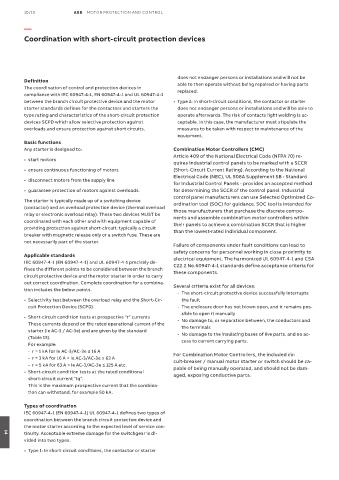Page 984 - ABB_Motor _Protection_and_Control_catalogue_20221216
P. 984
10/10 ABB MOTOR PROTECTION AND CONTROL
—
Coordination with short-circuit protection devices
does not endanger persons or installations and will not be
Definition
The coordination of control and protection devices in able to then operate without being repaired or having parts
replaced.
compliance with IEC 60947-4-1, EN 60947-4-1 and UL 60947-4-1
between the branch circuit protective device and the motor • Type 2: In short-circuit conditions, the contactor or starter
starter standards defines for the contactors and starters the does not endanger persons or installations and will be able to
type rating and characteristics of the short-circuit protection operate afterwards. The risk of contacts light welding is ac-
devices SCPD which allow selective protection against ceptable. In this case, the manufacturer must stipulate the
overloads and ensure protection against short circuits. measures to be taken with respect to maintenance of the
equipment.
Basic functions
Any starter is designed to: Combination Motor Controllers (CMC)
Article 409 of the National Electrical Code (NFPA 70) re-
• start motors
quires industrial control panels to be marked with a SCCR
• ensure continuous functioning of motors (Short-Circuit Current Rating). According to the National
Electrical Code (NEC), UL 508A Supplement SB - Standard
• disconnect motors from the supply line
for Industrial Control Panels - provides an accepted method
• guarantee protection of motors against overloads. for determining the SCCR of the control panel. Industrial
control panel manufacturers can use Selected Optimized Co-
The starter is typically made up of a switching device ordination tool (SOC) for guidance. SOC tool is intended for
(contactor) and an overload protection device (thermal overload those manufacturers that purchase the discrete compo-
relay or electronic overload relay). These two devices MUST be nents and assemble combination motor controllers within
coordinated with each other and with equipment capable of their panels to achieve a combination SCCR that is higher
providing protection against short-circuit: typically a circuit than the lowest-rated individual component.
breaker with magnetic release only or a switch fuse. These are
not necessarily part of the starter.
Failure of components under fault conditions can lead to
safety concerns for personnel working in close proximity to
Applicable standards electrical equipment. The harmonized UL 60947-4-1 and CSA
IEC 60947-4-1 (EN 60947-4-1) and UL 60947-4-1 precisely de- C22.2 No.60947-4-1 standards define acceptance criteria for
fines the different points to be considered between the branch these components.
circuit protective device and the motor starter in order to carry
out correct coordination. Complete coordination for a combina- Several criteria exist for all devices:
tion includes the below points.
- The short-circuit protective device successfully interrupts
• Selectivity test between the overload relay and the Short-Cir- the fault
cuit Protection Device (SCPD). - The enclosure door has not blown open, and it remains pos-
sible to open it manually
• Short-circuit condition tests at prospective “r” currents - No damage to, or separation between, the conductors and
These currents depend on the rated operational current of the the terminals
starter (Ie AC-3 / AC-3e) and are given by the standard - No damage to the insulating bases of live parts, and no ac-
(Table 13). cess to current carrying parts.
For example:
- r = 1 kA for Ie AC-3/AC-3e ≤ 16 A For Combination Motor Controllers, the included cir-
- r = 3 kA for 16 A < Ie AC-3/AC-3e ≤ 63 A cuit-breaker / manual motor starter or switch should be ca-
- r = 5 kA for 63 A < Ie AC-3/AC-3e ≤ 125 A etc. pable of being manually operated, and should not be dam-
• Short-circuit condition tests at the rated conditional aged, exposing conductive parts.
short-circuit current “Iq”.
This is the maximum prospective current that the combina-
tion can withstand, for example 50 kA.
Types of coordination
IEC 60947-4-1 (EN 60947-4-1) UL 60947-4-1 defines two types of
coordination between the branch circuit protective device and
the motor starter according to the expected level of service con-
tinuity. Acceptable extreme damage for the switchgear is di-
14
vided into two types.
• Type 1: In short-circuit conditions, the contactor or starter

